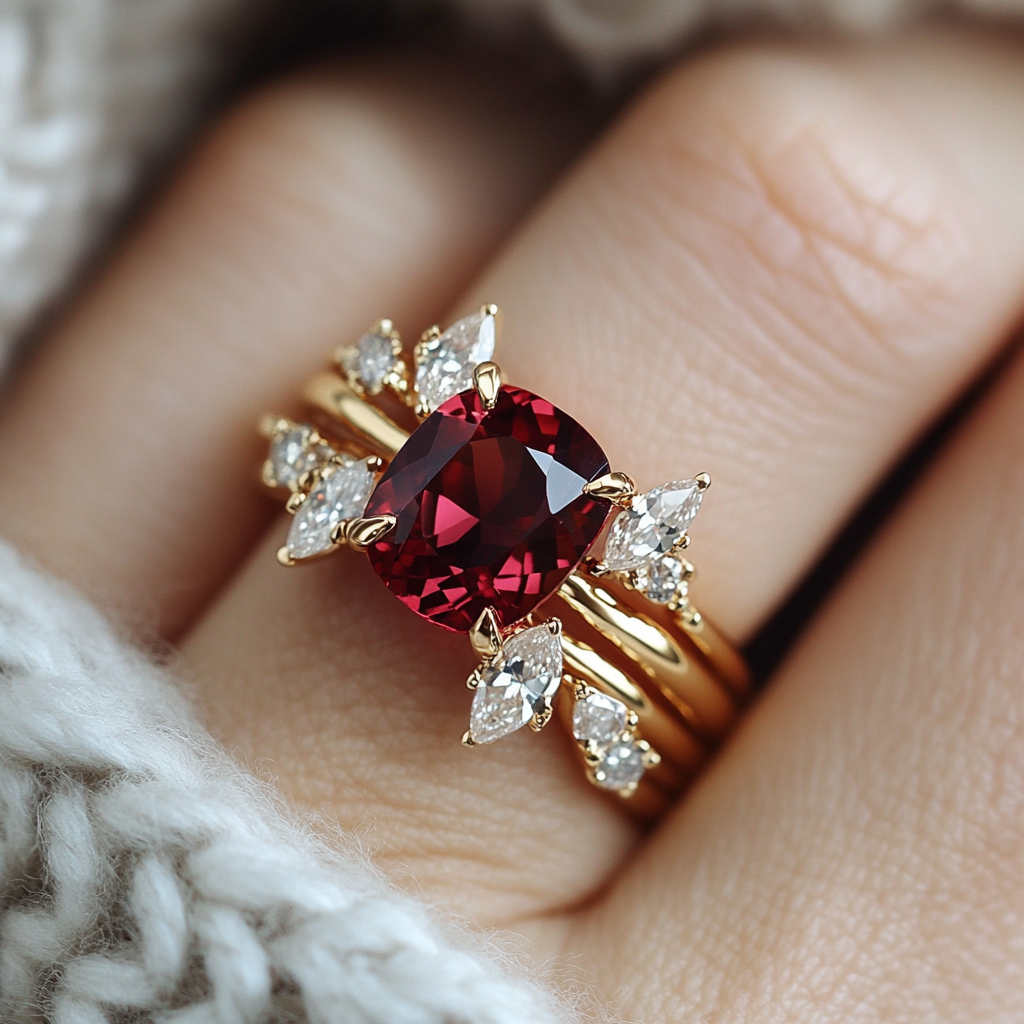Ruby Ring Price Guide
A ruby ring price guide helps you understand the key factors that influence the cost of a ruby engagement ring. The most important elements are the ruby’s color, clarity, cut, carat weight, origin, and any treatments it may have undergone. Deep, vivid red rubies—especially those with minimal inclusions and no treatments—are the most valuable.
Rubies from renowned origins like Myanmar typically command higher prices, while heat-treated or lower-clarity stones are more affordable. Additionally, the type of metal used in the setting (such as platinum or gold) and the inclusion of accent diamonds or design complexity can also impact the final price.
This ruby ring price guide offers a helpful overview for buyers seeking a balance between beauty, quality, and budget. Whether you’re investing in a timeless solitaire or a custom designer piece, understanding these factors ensures you make a confident and informed purchase.

Stone Cost
If the ruby ring in question is set with a natural, untreated ruby weighing well under carat, the ring will start out at prices around $1,000. In terms of the 4Cs, of color, clarity, cut, and carat weight, the ruby can have nice color, transparency, and will be cut nicely all for less than one carat. Larger rubies are exponentially rarer to find, much less in high quality.
R12319
Ruby ID: R12319 – Weight: 0.57 Carats – Price: $1,179.90
R12293
Ruby ID: R12293 – Weight: 0.62 Carats – Price: $1,178.00
R6531
Ruby ID: R6531 – Weight: 1.38 Carats – Price: $3,864.00
Importance of Color, Clarity, Cut, and Carat Weight
The main drive in the price of a ruby is its color. Pure, perfect reds described as “pigeons blood” command the highest prices. Often around three times as much as rubies with comparable weight but modified color. However, color preference is a very personal choice and not everyone likes a pure red.
R10037
Ruby ID: R10037 – Weight: 0.88 Carats – Price: $710.60
R7279
Ruby ID: R7279 – Weight: 0.76 Carats – Price: $355.30
R7268
Ruby ID: R7268 – Weight: 0.65 Carats – Price: $359.12
Clarity will not impact the price the way the color does, but having inclusions appear directly in the center of the gem is much less appealing than having them appear to the side less visibly.
Cut is extremely situational since gem cutters cut the most valuable ruby they can from the available carat weight. Determining the best appearance while balancing the issue is very difficult. As a result, somewhat irregular cuts have a low impact on the price.
A shallowly cut ruby displaying a window
R11949 | medium | play
Ruby ID: R11949 – Weight: 1.11 Carats – Price: $4,312.35
Ruby with a deeper cut without windowing
R12248 | medium | play
Ruby ID: R12248 – Weight: 1.12 Carats – Price: $4,662.00
Carat weight is different from the first three Cs since it is a measure of rarity instead of quality. Larger rubies are exponentially rarer, and the price is made to match this increase in rarity. Despite the limited number of people who can afford items like a $30,000 ruby weighing 3-4 carats, this is the rarity of these gems.
Other Pricing Factors
There are other pricing factors affecting ruby prices like treatments. A completely untreated ruby is much rarer than one that has been treated with heat. At one carat an unheated ruby will be around three times as expensive as one that has been heated, with the difference increasing with larger and rarer gems.
Ruby sources play a role too, like whether they are from Burma, Mozambique, Sri Lanka, Siam, etc. The pricing for specific sources depends on the vendor and the prices they can get for these gems.
Setting Costs
The general rule of thumb for setting a ruby (or any other gemstone) is that the cost of the setting does not exceed that of the ruby. A synthetic ruby will be much less expensive than a natural one, so much so that a plain silver band and the most basic setting costs might be higher than the price of the ruby alone. Note that the Natural Ruby Company only deals in heated and untreated natural rubies.
The least of the setting costs is usually the materials, even when using 18k gold. Costs mostly go towards the labor of setting stones into the ring. Rings with a lot more stones in them will have much higher labor costs too.


As illustrated above, adding the small diamonds in the second setting makes the price jump dramatically even though the amount of metal is roughly the same. Even when dealing in 14k white gold, the price of the setting will not decrease by much. Again, the bulk of the price goes towards labor. This pricing also applies to other types of ruby jewelry, like a ruby necklace, or ruby earrings. Once the baseline prices for the labor is established, in practice it is all very similar.
